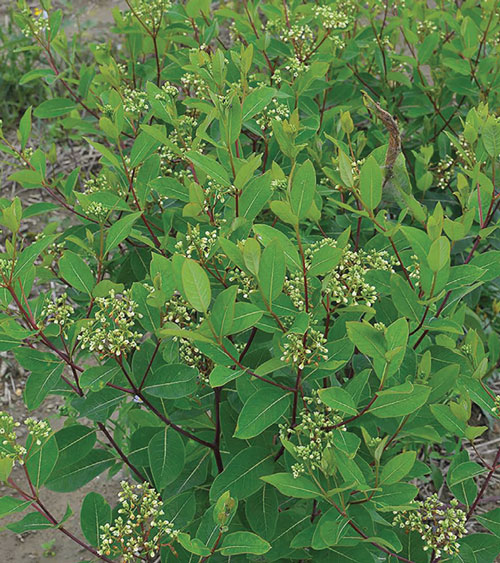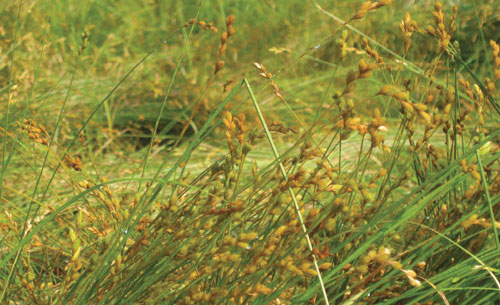Woodland openings can be developed to provide crucial early successional habitat between old growth forests and adjoining grasslands.
Typically in moderate shade; many native species are adapted to moderate shade and the protective habitat around trees; shade tolerant native grass species, such as Agrostis perennans (Autumn Bentgrass), Chasmanthium laxum (Slender Woodoats), Cinna arundinacea (Wood Reedgrass), Elymus hystrix (Bottlebrush Grass), Elymus riparius (Riverbank Wildrye), Elymus virginicus (Virginia Wildrye), and Panicum clandestinum (Deertongue), provide early protection for emerging herbaceous species. Note: For understory of longleaf pine plantings, high biomass producing species, such as switchgrass, big bluestem, and indiangrass, should be avoided. Fire can be too hot for longleaf pine seedlings or trees when these species are burned.
The addition of organic matter (compost) is most important. Check soil pH and select species adapted to that pH.
Hand seed, broadcast seed, or hydroseed. Use a garden rake, drag, or roll the surface to incorporate the seed into the soil 1/4”-1/2” deep. A seed drill may be used when sufficient room exists for operation.
These sites generally involve working around trees and shrubs while minimizing damage to trunks and roots. Undesirable vegetation must be controlled by tilling or direct spraying with glyphosate. Invasive weeds not addressed before establishment will be difficult to remove later. The soil needs to be loosened in order to establish seed-to-soil contact and dense leaf litter should be broken up with a rototiller. Seedlings can emerge from light leaf litter if planted at the proper depth. Light mulch or hydromulch can protect the seeds and soil until germination. Seeding and mulching around bioengineering material should occur immediately after installation. If installation cannot take place immediately after grading, temporary seeding and mulching are recommended.
Whenever canopy height (overall vegetation) reaches 18”-24”, trim the meadow to 8” using a brush hog mower or string trimmer. Trimming reduces competition by fast-growing weeds for sunlight, water, and nutrients needed by slower growing perennial natives. A lawn mower is not recommended as the mower height will be too low and native seedlings will be killed.
If bioengineering materials were used on the site, mowing should be above the new growth of these materials. Trimming should cease by mid-September.
Problem weeds should be hand pulled or spot sprayed with an approved herbicide, such as Roundup®, Rodeo®, Garlon®, Garlon® 3A, Stinger®, or Milestone®. Be vigilant in controlling vines or spiny plants if they were not part of the mix. These are more easily pulled early than after they have had two to three months of growth. Examples include bindweed, blackberry, multiflora rose, mile-a-minute, and Japanese hops. Be equally vigilant in the control of other invasive species, such as autumn olive, Canada thistle, and mugwort.

Prior to new spring growth reaching 2” (e.g., shortly after forsythia or redbud blooms), trim any material standing from the previous year close to the ground (approximately 2”). This will allow the soil to warm more quickly, stimulating emergence and growth of herbaceous native plants and reducing invasion of woody undergrowth. In certain ecosystems, controlled burning by certified professionals can achieve the same results.
If bioengineering materials were used on the site or seed of shrubs/trees were part of the mix, the site should not be trimmed after the establishment year.
Problem weeds should be hand pulled or spot sprayed. Be vigilant in controlling vines or spiny plants if they were not part of the mix. These are more easily pulled early than after they have had two to three months of growth. Examples include bindweed, blackberry, multiflora rose, mile-a-minute, and Japanese hops. Be equally vigilant in the control of other invasive species, such as autumn olive, Canada thistle, and mugwort.

If there is a heavy infestation of ragweed or foxtail in the second growing season, trim the meadow to 8”. Trimming should cease by mid-September.
Find more seeds and seed mixes using the advanced search and filtering options of our Seed Finder Tool.
DISCLAIMER: The information in this review of practices is the result of more than 50 years of experience in seed production. Ernst Conservation Seeds has been supplying seeds and consulting in the reseeding of tens of thousands of acres of roadsides, surface mined lands, conservation, and restoration sites in eastern North America, as well as growing and supplying seed and consulting in the planting of hundreds of thousands of acres of CRP/CREP-related areas for erosion control and wildlife habitat. All of these practices are opinion only and our best advice as a result of these experiences. These recommendations do not cover all the conditions that will be encountered in the field. All of the information is for individual consideration. Ernst Conservation Seeds is not responsible for conditions that will be encountered in individual situations. The use of brand names does not represent our endorsement of a specific product; rather, it represents our experience only and has not necessarily been replicated in peer-reviewed research. The use of chemical pest control agents is subject to manufacturers’ instructions and labeling, as well as federal, state, and local regulations.
Ernst Conservation Seeds
8884 Mercer Pike
Meadville, PA 16335
(800) 873-3321
sales@ernstseed.com
© 2025 Ernst Conservation Seeds | Privacy Policy